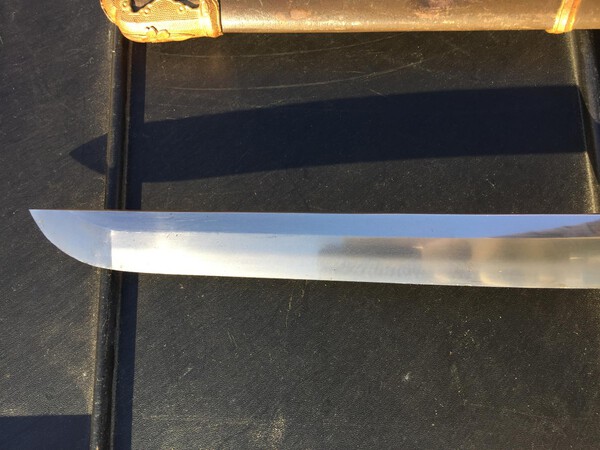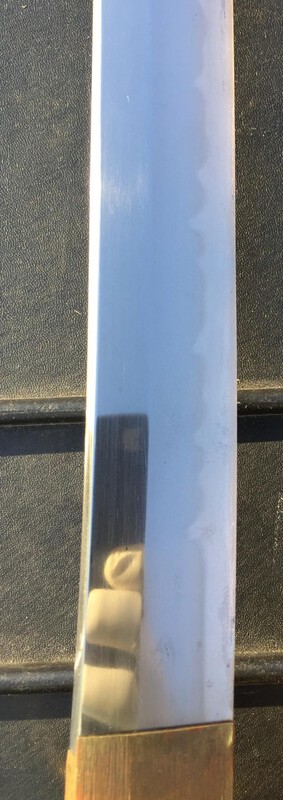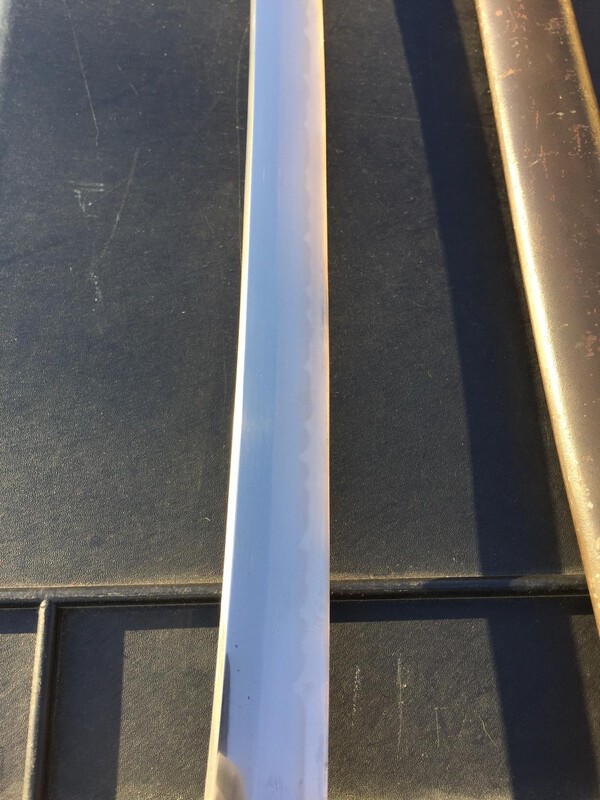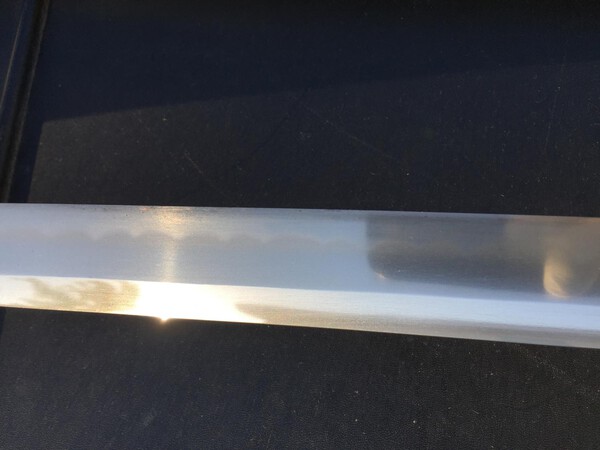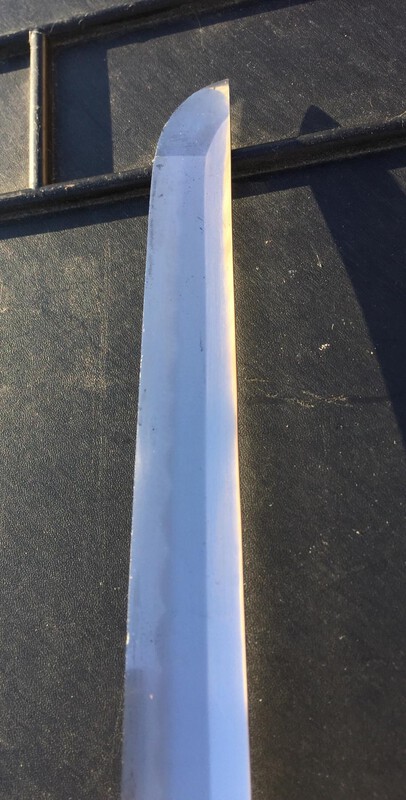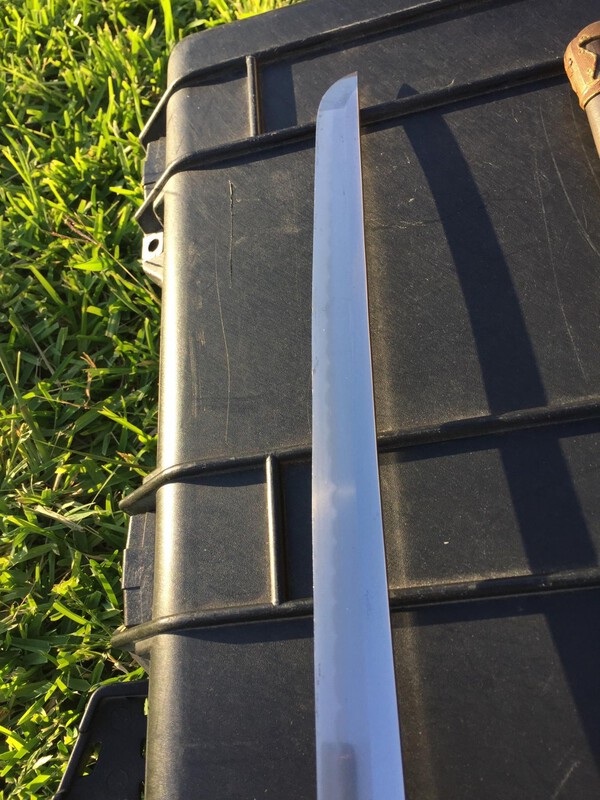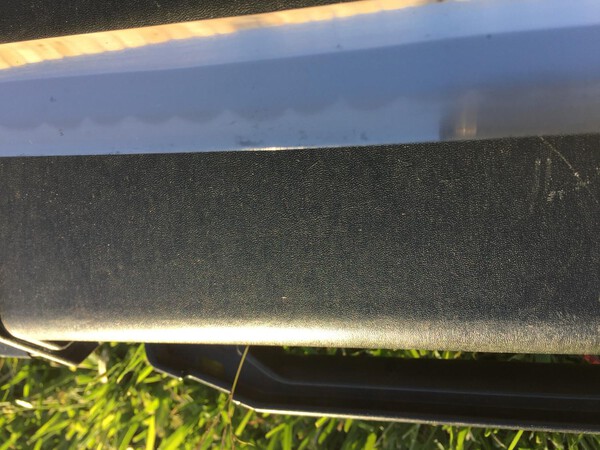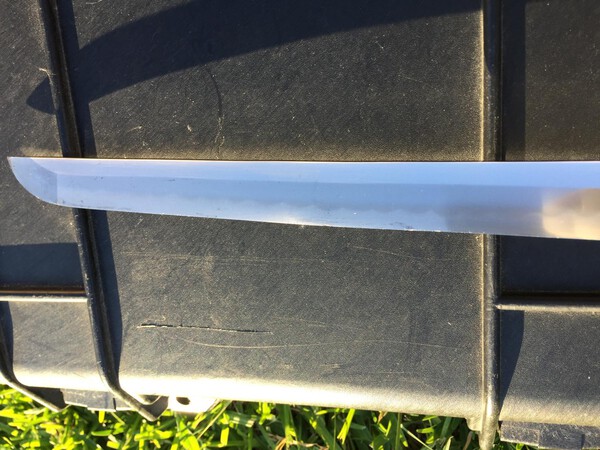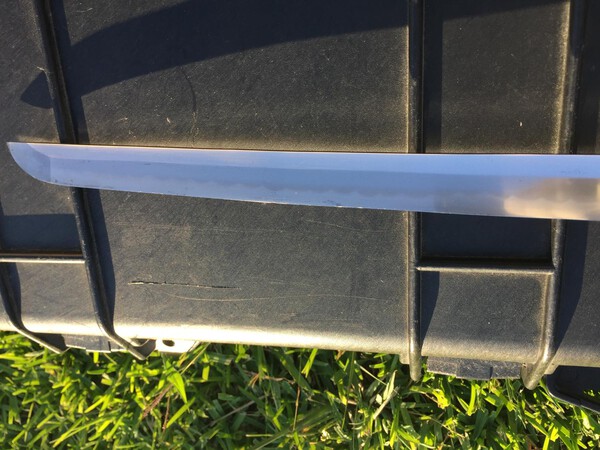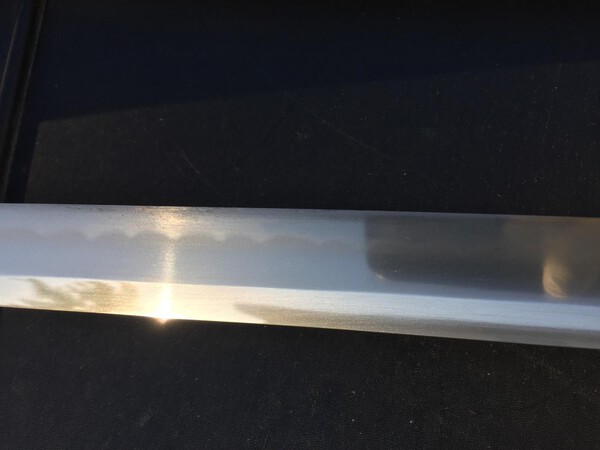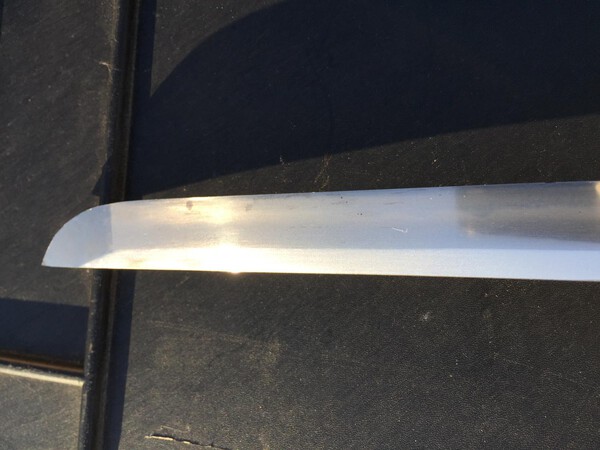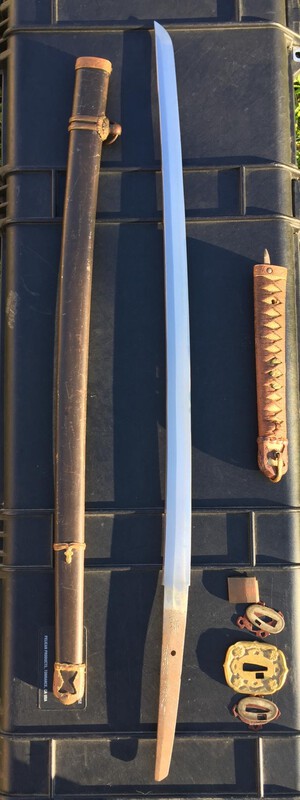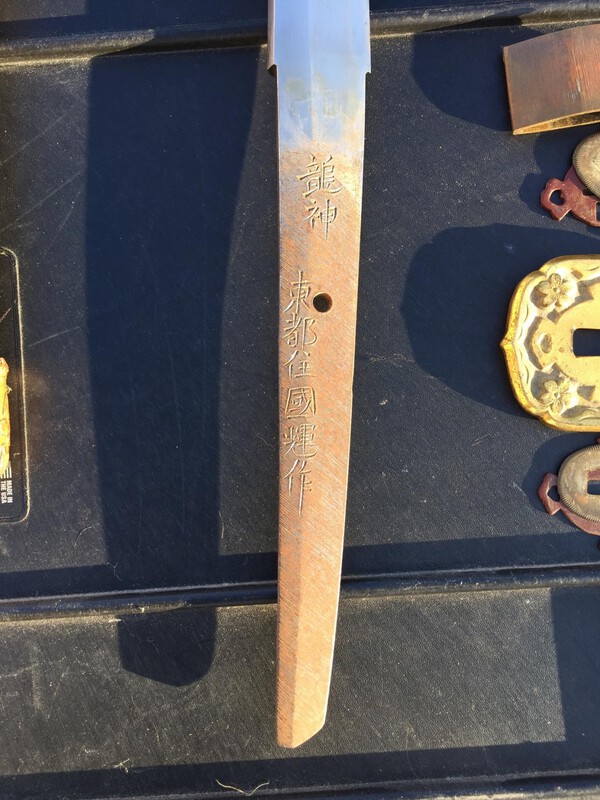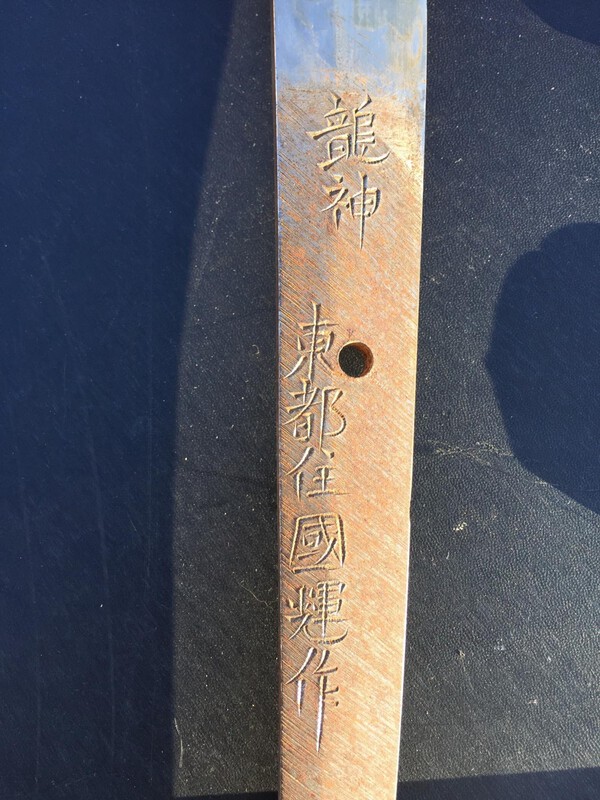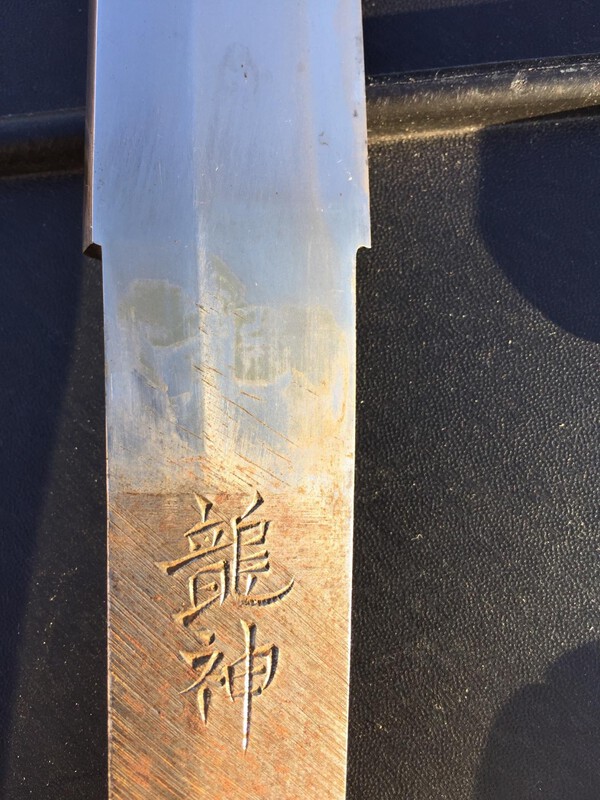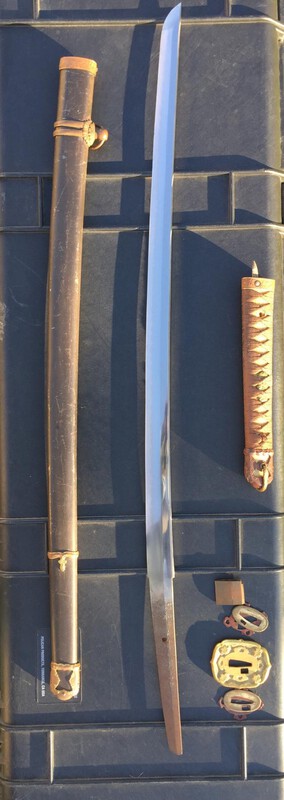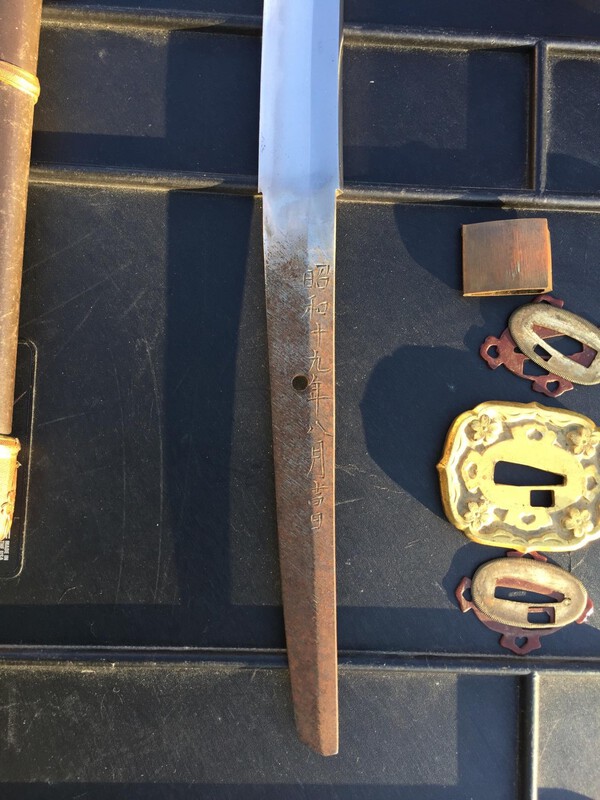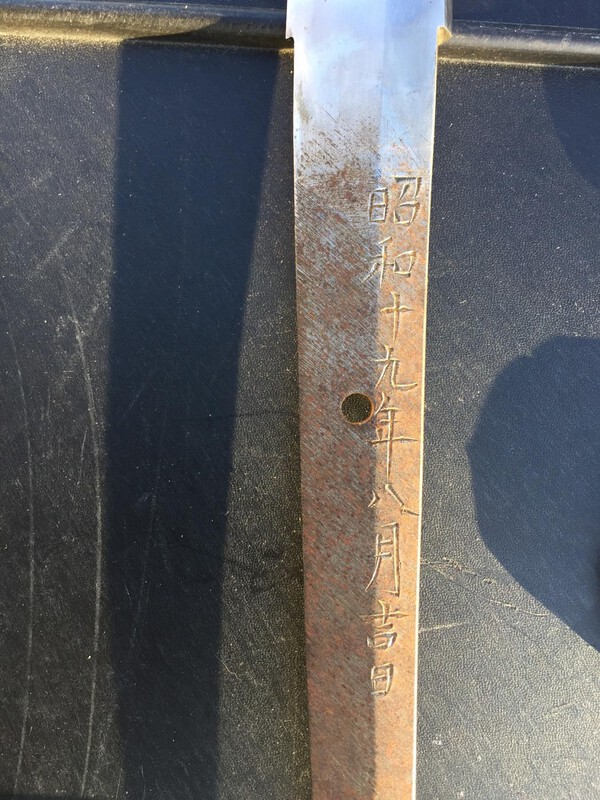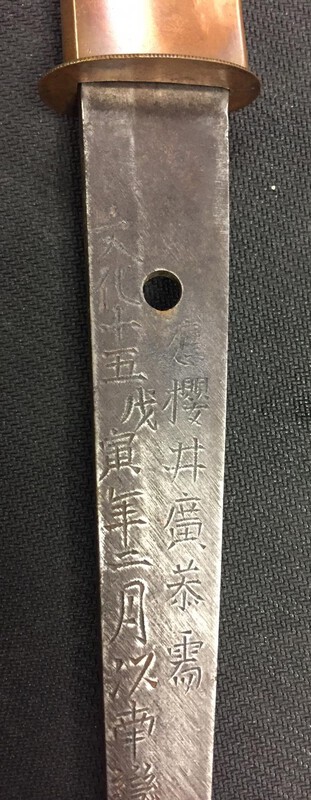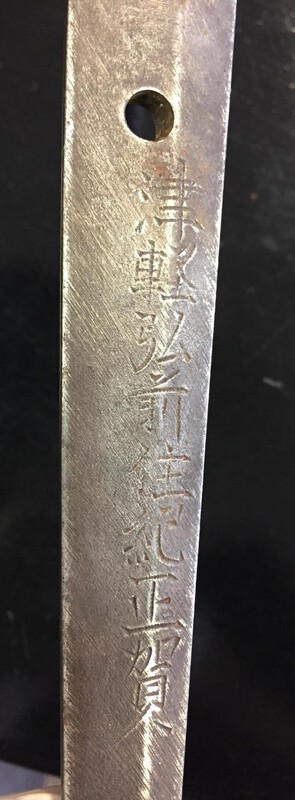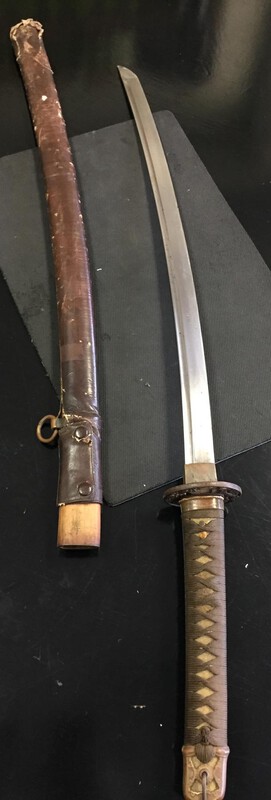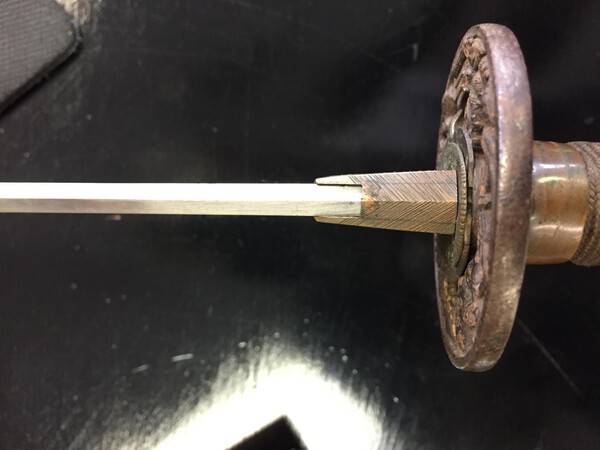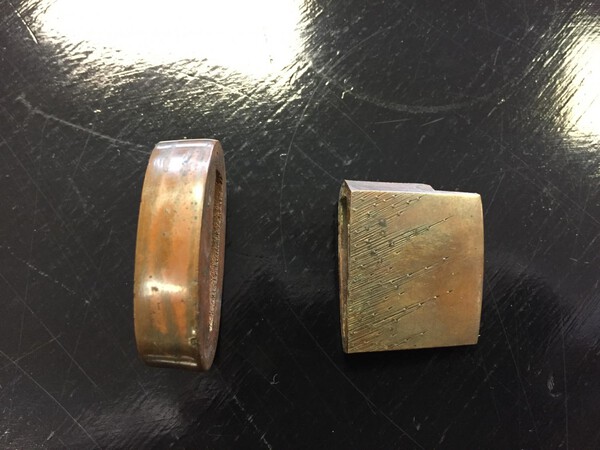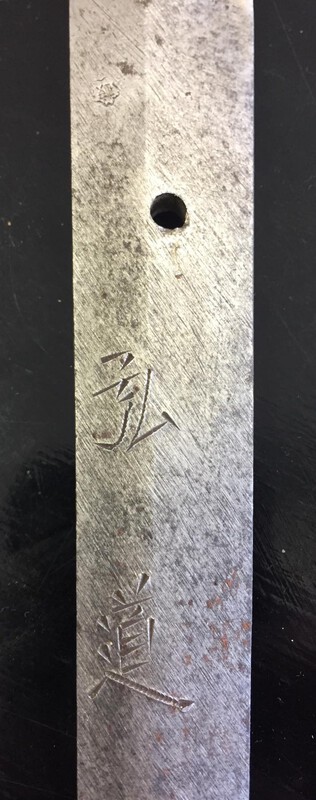
Navymate
Members-
Posts
51 -
Joined
-
Last visited
Everything posted by Navymate
-
As I continue my research, I have a couple questions that keep nagging at me and wanted to ask more experienced collectors than myself. First is in regards to care, as I’m sure you all have noticed that the nakago has developed some light red rust. I have read the recommendations that say to never touch the nakago and leave it alone. I’ve also seen where some suggest to stop the active rust by wiping the nakago down with oil and a clean section of rag. Should I leave it alone or wipe it with oil? This sword is probably not near as nice as what most of you are used to, however, as the current caretaker I want to make sure I treat it with respect and care for it properly. My second question is this: Can you tell if the sword is made of yo-tetsu aka Western steel by the pictures? I will preface this question by saying I’m assuming that it is not possible to answer accurately without the sword being in proper polish or without having the blade physically in hand. However, in case I’m wrong about that assumption I thought I should ask more experienced collectors. The reason I ask about yo-tetsu is that I have not been able to find much information about Kuniteru (if that translation is indeed accurate) other than a few references. One of which is a post in which a book titled, “Modern Japanese Swords: The Beginning of the Gendaito era Paperback – July 21, 2015 by Mr Leon Kapp (Author), Ms Hiroko Kapp (Author), Mr Leo Monson (Author)” is being discussed. Link: http://www.militaria.co.za/nmb/topic/17425-new-book-out-modern-Japanese-swords-the-beginning-of-the-gendaito-era/ One of the threads says the book mentions a “Ryujin Ikkansai Kuniteru” blade/smith. The post also mentions a review by “Chris A. Bowen” (which if it is actually him, then he is obviously well known and respected) in which the review mentions inconsistencies and errors in the book, but also mentions the mei Kunimori and his well-known yo-tetsu connection. Another tidbit of information I have found was a post in which a member posted a similar mei for a Ikkansai Kuniteru Ryu Jin sword. In subsequent posts it was suggested that his sword may have been made of yo-tetsu like those with the Kunimori mei (due to the idea that Kuniteru was a student of Miyaguchi Ikkansai aka Yasuhiro). Personally, since this is coming from Chris Bowen, who is in high regard for his knowledge of Nihonto, I trust his assessment. Link: http://www.militaria.co.za/nmb/topic/12933-yasukuni-swords-in-type-3-mounts/page-2 “cabowen said: Posted 17 November 2013 - 09:47 AM Rare mei. I don't think I have seen another. Must have worked with Miyaguchi at the Okura Tanrenjo. Probably also made of yotetsu like the Kunimori mei Miyaguchi blades.” Additionally, I will have to acknowledge what Geraint had discussed previously about the inconsistencies with the other Ryu Jin Kuniteru mei that was posted up as a comparison. As I continue to research this, I have more questions than answers, such as why the “Kuni” kanji on my blade is more similar to the way Kunimori signed, rather than the “Kuni” kanji on the other Ryu Jin Ikkansai Kuniteru mei posted by another member? The placement of the signature is different as well. So, what do the rest of you think? Thank you for taking the time to help, Mark
-
Oops I see I made a mistake. The kasane measurement is incorrect and should be 0.3125 inch and (0.79375 cm). Mark
-
Here are some approximate measurements: Overall length: 34.8125 inches (88.42375 cm) Length of Edge (Hamachi): 26.75 inches (67.945 cm) Length of Nakago: 8.0625 inches (20.47875 cm) Mihaba (width) at Munemachi: 1.3125 inches (3.33375 cm) Mihaba (width) at Yokote: 0.875 inch (2.2225 cm) Length of Kissaki to Yokote: 1.3125 inches (3.33375 cm) Kasane (thickness): 0.79375 inch (2.016125 cm) Thank you for the help. Mark
-
Here are some more pictures to show the blade in a little better detail. I tried to capture a few different angles. Thanks for taking the time to check it out. Mark
-
Geraint--Thank you for your observations. I agree with your statements about the difference of placement of the kanji and also the nakago jiri. Those are some of the reasons I keep scratching my head. Admittedly, I am a novice so I don't have the experience in examining and analyzing all the details yet, but I'm working on it. That being said, there seem to be similarities to Kuniteru and/or possibly being associated with Okura Tanrensho Dojo due to timeframe. Maybe it's a wild guess. I appreciate your input, thank you. Robert S.--Thank you, I will post more pictures later to show some of the blade details better. Stephen--If this is indeed a Kuniteru blade, then it is possible yes he could have been a Yasukuni smith. The first link I reference above has the only information I have been able to find about Ikkansai Kuniteru. According to the post he was a student of Yasuhiro and referenced once as Ikkansai Hirokazu. One of my follow up questions would be--if this is a Kuniteru made blade--what are the chances that this would be a sword made with yotetsu since Kunimori signed blades are made with it? I'm probably putting the cart before the horse, so it will be interesting to see what others think. Thank you all for your insight, Mark
-
I am very excited as I was able to acquire my first sword recently. The members here have been very kind and generous with your knowledge on my previous requests, so I thought I would double check here and make sure my translation is correct. I have been researching it for a few weeks now and if I’m right then I will have some follow up questions from the research I’ve done. But for now I want to verify with others more knowledgeable than myself. This is what I have: Showa Jyu Ku Nen Hachi Gatsu Kichi Nichi A lucky day in August 1944 Ryu Jin Toto Ju Kuni Teru (?) Saku Dragon King/God Kuniteru made this in Tokyo I have not been able to find much about Kuniteru other than this previous post: http://www.militaria.co.za/nmb/topic/12933-yasukuni-swords-in-type-3-mounts/page-2 It starts on page 2, post 39 by EdO. He posted a similar Mei that showed Ikkansai Kuniteru and the kanji for Teru looked similar to this one. However the Kuni kanji on the nakago on the post has 2 vertical marks in the lower left hand, whereas the Kuni kanji on the blade I have, is 1 horizontal mark. I am a novice so I could be completely wrong, but there appears to be similarities in signing. The sword in the post is also named Ryu Jin. Of note, there is also another Ryu Jin named sword I found online here: http://www.samuraisword.com/nihontodisplay/Gendiato/Yasuhiro/index.htm What do you think? Thank you for your time and input. Mark
-
Mei Translation Help Cont’D (3Rd And Final One Of The Lot)
Navymate replied to Navymate's topic in Translation Assistance
Geraint-- Thank you for the kind words and for the assistance you have so generously given me. I will absolutely post pictures if I am able to acquire this one. Even if I am unable to, I think I will be able to get pictures. However, I will have to state that it is in pretty poor condition with an out of polish blade so the pictures won't be great. That said, this one really "spoke" to me. Even though there was a better looking tsuba on the sword with the bohi and the hamon on the Kanetaka is much more visible and traditionally made, I got the impression this one had a good story to tell me. It is kinda like me, wore out and beat up, but still capable. Mark -
Mei Translation Help Cont’D (3Rd And Final One Of The Lot)
Navymate replied to Navymate's topic in Translation Assistance
Steve, Thank you for your translation and for the clarification of adding nanbantetsu to the tamahagane. That makes absolute sense, I was not thinking about it correctly. My knowledge is very limited at this point, however I am continuing to benefit from the generosity of you and others here. I have some interesting reading to do about nanbantetsu and have only scratched the surface. I am incredibly appreciative for your insight, thank you. Mark -
Mei Translation Help Cont’D (3Rd And Final One Of The Lot)
Navymate replied to Navymate's topic in Translation Assistance
John-- Thanks again for the follow up information. I will look into the research by Markus Sesko and also the namban tetsu and oranda tetsu as you have suggested. And by the way, there is nothing to apologize for. You are doing me a huge favor by offering up your knowledge. I can't say for certain, but this sword is most likely the only one I would be able to purchase of the lot. It looks pretty rough so when my friend first showed it to me I figured it would be the only one I could afford as the other 2 (previous 2 posts) are nicer looking and the one late production Seki stamp Hiromichi isn't my cup of tea. Once I looked at the nakago, I figured it had some stories to tell. So I really appreciate all the help you have offered. Barry-- Thank you for providing those details about nanban tetsu and Yukihiro. I will look into that as well. Much appreciated, Mark -
Mei Translation Help Cont’D (3Rd And Final One Of The Lot)
Navymate replied to Navymate's topic in Translation Assistance
John-- Thank you for taking the time to not only to help out but to also walk me through your translation. If you are indeed correct about the use of "barbarian steel" I find that fascinating. On one side it is a little disappointing (even though the swords are not mine, just doing the research), and on the other I find it curious as to why someone would select foreign steel over tamahagane. Very interesting indeed. With my limited knowledge I was assuming the kanji for barbarian steel - "ban tetsu" - was the smith's name due to it preceding the "saku kore." But with the offset kanji and the amount of kanji present I was suspect that it may be something else. For the date I had suspected Bunka JyuGo ? ? Nen Ni Gatsu which puts the date as a possibility of Feb. 1818 (Bunka 15). So maybe that makes sense with your translation of "tsuchinoe-tora toshi" falling on 1818 as well if we use 15 years as opposed to 50. It could also be I've flipped my numbers as I do that frequently. That is a great note about this still hopefully being a quality made blade even though it is not made using traditional steel. The blade is out of polish so seeing any activity is very difficult at this point. I really appreciate all the information that you have provided and the link to another example of the smith. Lots of interesting reading to do. Thank you again, Mark -
Here is the last sword of the lot of 4 I mentioned in an earlier post. This one appears to be a mixed lot like the last one I posted but this has a much more to translate. I have spent long enough pulling out what’s left of my hair trying to figure out all of this and will now again ask for help. There is a really faint kanji on the top of the right column on what I think is the signature side. I’ve tried to include the best picture of it. Thank you for taking the time to help. Mark
-
Thank you again Mr. Trotter for taking the time to break it down into that much detail. Your explanation and knowledge has really helped me grasp a better understanding. Even a novice as myself realizes what a treasure you have in your Nakata Kanehide sword! Truly amazing and thank you for sharing that with me. Mark
-
This is fantastic — thank you SteveM! I can absolutely see your point about misreading one or both kanji of his family and personal name. I had been looking at this mei for over 2 weeks and getting no where so I am incredibly thankful for you taking the time to explain this somewhat tricky situation in such detail. Your explanation is detailed and very informative. Thank you, Mark
-
Mei Translation Help Continued (Sword 2)
Navymate replied to Navymate's topic in Translation Assistance
Thank you again sir. Incredibly helpful and generous. -
Mei Translation Help Continued (Sword 2)
Navymate replied to Navymate's topic in Translation Assistance
Geraint, Thank you for the information and indicators about the unassociated mixture of seppa. These 4 swords are my first opportunity to examine a real sword in person so I appreciate you pointing out exactly what and why. While looking at this one I too thought it interesting that the fittings were not matching and also why the cheap looking seppas were present. I did get a chance to look at the tsuba briefly today and I did not see any stamps, mei or symbols on the edges (both inner and outer). It is however the most detailed design of the group. I have been looking at some information about how to help identify a sword without a mei and have been reading about the pattern of file strokes, the overall shape of the nakago and also the shape or cut of the tip of the nakago. As I’m beginning to understand better I realize the incredible depth of knowledge you all have amassed. It is amazing and quite humbling. Oh, if you thought this sword was an unassociated mix then the final sword of the bunch will make you chuckle. I’ll post pictures of that one soon. It has lots of legible kanji on the nakago. Thank you again, Mark -
Mei Translation Help Continued (Sword 2)
Navymate replied to Navymate's topic in Translation Assistance
Thank you again for your knowledge and help Mr. Singer. Mark -
Mei Translation Help Continued (Sword 2)
Navymate replied to Navymate's topic in Translation Assistance
Hahaha yes numbers are one thing I can handle ???? well sometimes at least. Thank you for helping with this. Mark -
Mei Translation Help Continued (Sword 2)
Navymate replied to Navymate's topic in Translation Assistance
In reply to the questions about EBay, honestly I don’t know. From what I understand an older gentleman brought in this sword along with 3 others into my friend’s store as trade on something. I spoke with the older gentleman briefly when he brought some general Nihonto information he had printed to my friend’s store while I was there. If I can I’ll ask him about where he purchased them. These have been at the store for about a month. I was under the impression the gentleman who owned these had them for some time, but I cannot say for certain. Mark -
Wow! Thank you Mr. Trotter very much for the information and scans you have provided, that is very kind of you. I didn’t mean for you to fall down into a rabbit hole, but in doing so I have some fantastic information and a great place to continue researching. It is truly amazing the scope of knowledge everyone has been so generous to share, thank you. Mark
-
Here is the second sword of the lot I mentioned in my earlier post. I don’t think much information can be gleaned from the mei on the nakago as most of the kanji are worn off and only a few can be faintly seen on one side. However, this sword has different mounts from the previous two WW2 swords I have posted and personally I think this one is much more detailed and interesting. I wasn’t able to get measurements when I took the pictures but will get them tomorrow when I stop by. That being said, this sword is the shortest of the 4 swords and with the Bo-hi, it is obviously significantly lighter and incredibly fast in the hand. It has the leather combat wrap saya. The sword appears to be in fair shape, not mint mind you as there are a couple small chips, but it seems to be a nice blade overall and it has a well made tsuba and fuchi, especially compared to the others in the lot. I don’t know if someone attempted to do a poor self polish on the blade or not but the Hamon is not as bright as the earlier blade I posted. I can see it but it’s difficult to capture on the pictures. Overall I think this sword is probably the nicest of the 4. (I will try and post the last sword tonight) I thought I would share and I might just learn something along the way. Sorry if there are too many pictures. Thanks.
-
Thank you gentlemen, the help is greatly appreciated. Even though this sword isn’t in museum condition the Hamon is “bright” and visible compared to the other 3 swords. The Army mounts are all matching numbers and seem to be in good condition. Overall I think it’s a beautiful sword. The pics aren’t great but here are some pictures. I will post pictures of the other 2 swords later today when I have some more free time. Thank you again for all the help. Mark
-
I’m sorry it took so long to respond back, my 2 year old son is sick and I needed to spend time with him last night. Here are some more pictures of the last symbol. Thank you both, Mr. Stuart and Mr. Singer, for being so generous with your knowledge. I have drooled over many of the items on your website Mr. Singer, incredible collection. I’d be glad to post any and all pictures needed. Thank you again. Mark
-
Post All, I was so impressed with the generosity of knowledge and the abundance of such with my first post (in which I asked for translation help on a late WW2 production blade) that I have a unique situation that I’m hoping I can get some advice and translation help. The previous sword I mentioned is not mine but that of a friend who has a retail store close to where I live. He knew that I had some interest in Japanese blades so he asked if I would be interested in doing some research. Being my first opportunity to appreciate a Japanese sword (arguably so due to its non-traditional method of manufacture), of course I jumped at it. Clearly, I’m a novice at best but nonetheless it has been fascinating and educational. The friend who has a retail store apparently had someone who brought in 4 swords as trade or as an estate sale. Normally he doesn’t deal with any swords, so he’s asked me to help him. I explained the protocol to him about making a donation in appreciation of the help and knowledge received so if/when he sells them he or I will make sure the donation is made. He knows that my knowledge is limited at best and that the information on the previous HIROMICHI sword came from this generous forum, so thank you again. The first of the 3 remaining blades will be included in this post and the others will be in subsequent posts. It is in WW2 Army mounts. The date seems to have worn off as there are faint traces of what appear to be white paint/lacquer. The mei has been difficult for me to decipher and was hoping for some assistance. I have some possibilities for each kanji with the exception of the first one. The last 2 kanji are somewhat obscured so I’ve tried to show different angles on the pictures. It appears to me that there are 8 kanji present. Please forgive any obvious errors. [1. ???, 2. katsu, 3. Seki, 4. Ju, 5. Gen or Moto (maybe Minamoto), 6. San, Kuni, Mi, Mitsu, etc., 7. Yoshi or Yori (but I think it might be Kuni or Hou in certain light), 8. Saku; Nari or Suke; or a variant of San, etc.)]. To save space I will just post pictures of the nakago. If more pictures are needed I will gladly provide them. Thank you
-
Wow! Thank you both for the information provided. I am incredibly grateful. Thank you.
-


